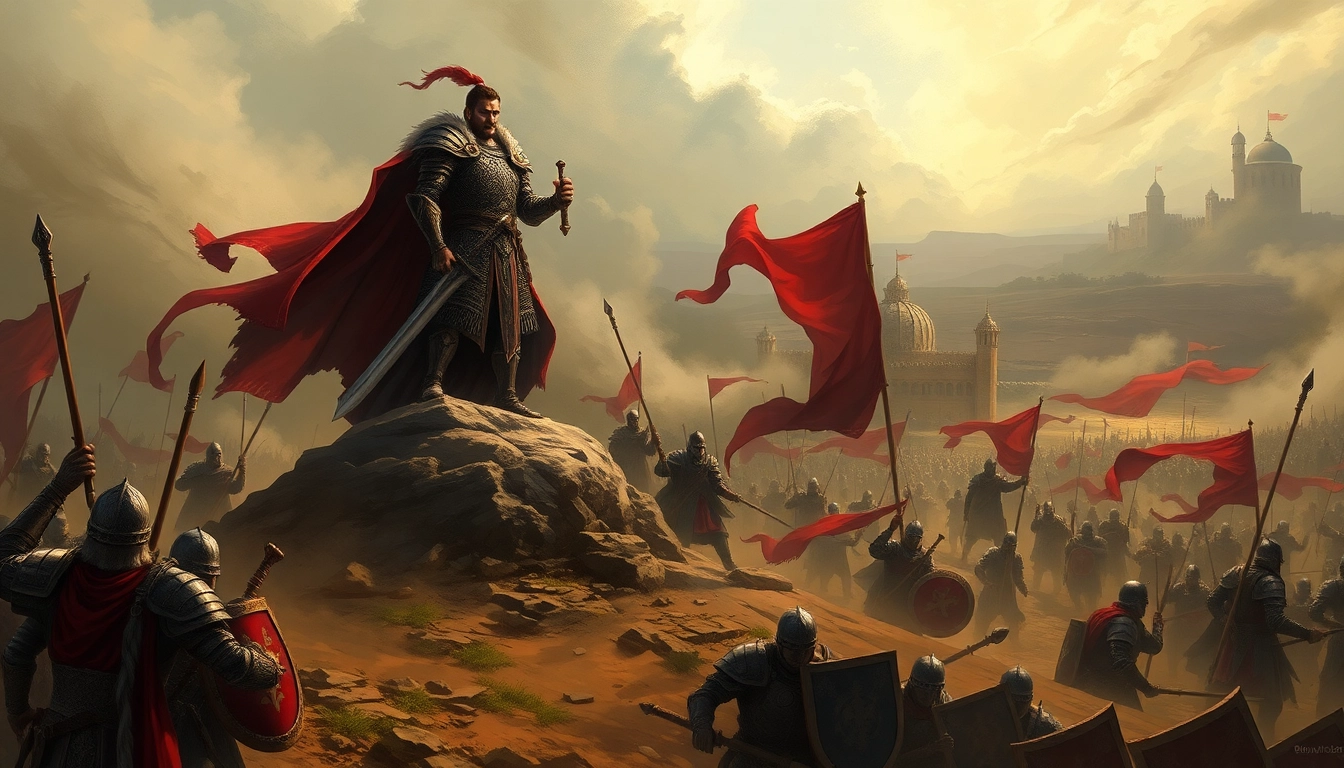Understanding the Role of Warlords in Strategy Games
The concept of warlords has captivated gamers for decades, especially in the realm of strategy games. These commanding figures embody not only the capacity for leadership but also the intricacies of tactical warfare. From ancient battles to modern gaming, the role of warlords has evolved significantly, influencing gameplay mechanics, character development, and player strategies. In the following sections, we’ll delve into the multifaceted nature of warlords in gaming, exploring their historical evolution, defining characteristics, and their impact on gameplay dynamics.
The Evolution of Warlords in Gaming
The journey of warlords in gaming began with a simplistic portrayal of leaders in strategy games. In early titles, such as the original “Warlords” series, warlords were essentially avatars representing players on the battlefield without much depth or narrative. However, as technology advanced and storytelling became more integral to game design, the characterization of warlords evolved considerably.
By the late 1990s, games like “Warcraft” and “Command & Conquer” began to introduce complex leaders who each had unique abilities and backstories. These characters not only drove the game’s narrative but also influenced gameplay through their unique skills and traits. As the genre matured, modern titles such as “Total War” and “Warlords Battlecry” provided players with the tools to mold their own warlords, offering deeper customization options and making leadership roles more engaging.
Key Characteristics of Effective Warlords
Effective warlords share several key characteristics that influence their success in strategy games. These include:
- Strategic Acumen: Warlords must possess excellent planning skills to outmaneuver opponents.
- Charisma: A compelling leader can inspire loyalty among troops and secure their commitment.
- Adaptability: The ability to adjust strategies in response to opponents’ actions is crucial in fast-paced gameplay.
- Resource Management: Warlords must efficiently allocate resources to maintain a powerful army.
These characteristics not only enhance gameplay but also provide players with a sense of immersion, as they assume the role of these multifaceted leaders within their strategic universes.
Famous Warlords in History and Their Influence on Games
Throughout history, numerous warlords have become legendary figures, and their stories have inspired countless games. Leaders such as Genghis Khan, Alexander the Great, and Sun Tzu not only changed the course of human history but have also heavily influenced how characters are portrayed in modern computing.
For instance, the “Total War” series draws heavily on historical warlords to develop gameplay mechanics and narrative arcs. Players can emulate famous leaders, employing their unique tactics and strategies, fostering a deeper connection to history and offering a richer gaming experience.
Gameplay Mechanics: How Warlords Shape Victory
In strategy games, the warlord’s role is not just to lead but also to shape the very mechanics of gameplay. From combat strategies to resource management, their impact is profound.
Combat Strategies Employed by Warlords
Combat in strategy games often hinges on the warlord’s abilities and tactics. Players must consider various factors such as troop composition, terrain, and enemy strengths. Effective warlords utilize a range of strategies, including:
- Flanking Maneuvers: By attacking from the side or rear, warlords can catch opponents off-guard, maximizing damage and morale.
- Defensive Positioning: Utilizing high ground or fortifications can turn the tide in battle, making it difficult for enemies to advance.
- Unit Synergy: Combining different unit types can create powerful forces, such as pairing infantry with cavalry for a more balanced attack.
An effective warlord not only understands these strategies but can also adapt them based on the evolving battlefield dynamics, which adds an exciting layer to gameplay.
Resource Management: Sustaining Your Army
A warlord’s effectiveness in combat is greatly influenced by their ability to manage resources. This entails gathering materials, recruiting troops, and ensuring a sustainable economy. Players must:
- Prioritize Resource Gathering: Establishing supply lines and harvesting resources efficiently can determine the availability of troops and equipment.
- Invest Wisely: Allocating resources towards technological advancements and improving troop capabilities can provide an edge over opponents.
- Maintain Morale: Providing adequate supplies and support keeps troops motivated, directly impacting performance in battles.
Overall, astute resource management plays a pivotal role in a warlord’s journey from obscurity to dominance.
The Importance of Terrain in Warlord Gameplay
Understanding and utilizing terrain is fundamental in strategy games. Warlords often leverage geographical features to enhance their tactical advantages. Factors include:
- Elevation: Higher ground provides better visibility and defensive benefits, offering a strategic advantage in battle.
- Natural Barriers: Rivers, mountains, and forests can limit enemy movement and provide safe zones for regroups.
- Urban Areas: Cities can serve not only as economic centers but also as strongholds that require tactical planning to conquer.
Thus, effective warlords must consider terrain in their strategies, using it as both a defensive mechanism and an offensive tool.
Building a Warlord Character: Customization and Personalization
One of the most engaging aspects of modern strategy games is the ability to build and customize a warlord. Personalization is key to fostering player investment and creating unique gaming experiences.
Choosing the Right Skills for Your Warlord
The selection of skills is critical to the effectiveness of a warlord. Players can enhance their character abilities tailored to their preferred gameplay style. Some skills include:
- Leadership: Boosts unit morale and effectiveness.
- Tactics: Improves strategic options in battles.
- Resourcefulness: Enhances resource gathering rates and efficiency.
Each choice can significantly impact gameplay, allowing for diverse approaches tailored to personal preferences or specific mission requirements.
Portraits and Identities: Crafting Your Warlord’s Backstory
The backstory of a warlord adds depth to gameplay. Players can create rich narratives for their characters, which may influence their interactions with other characters and factions within the game. Crafting a compelling identity involves:
- Origins: Defining the warlord’s past, upbringing, and experiences can provide motivation for their current actions.
- Relationships: Building relationships with other characters can lead to alliances or rivalries, influencing gameplay outcomes.
- Aspirations: Establishing goals for power or revenge can drive the character’s choices throughout the game.
By investing time into developing a warlord’s identity, players can deepen their engagement and enhance their overall enjoyment of the game.
Weaponry and Armor Selection
The choice of weaponry and armor is another crucial aspect of character customization. The right equipment can define a warlord’s battlefield role, making this a significant area for player consideration. Key elements include:
- Weapon Types: Different weapons provide various advantages such as range, speed, and damage output. A warlord might opt for heavy armor and melee weapons or favor agility and ranged options.
- Armor Class: Choosing appropriate armor affects survivability and mobility, allowing for tactical choices based on gameplay style.
- Customization Options: Many games offer players options to modify gear for improved performance, making each warlord even more unique.
Thus, weaponry and armor choices allow players to craft a warlord that aligns closely with their strategic preferences and combat style.
Analyzing Warlord Mechanics in Popular Games
Popular games have successfully integrated warlord mechanics, creating engaging and strategically rich gameplay. Understanding these mechanics can provide invaluable insights for players looking to improve their strategies.
Case Study: Warlords in ‘Warlords Battlecry’ Series
The “Warlords Battlecry” series exemplifies the effective integration of warlord mechanics. This real-time strategy game allows players to create their warlords using an RPG-like system. Key features include:
- Hero Development: As players progress, their warlords gain experience and skills, encouraging diverse gameplay approaches.
- Army Composition: Players can build and customize armies that complement their warlord’s strengths, fostering unique play styles.
- Status Effects: Certain warlords can apply status effects during battles, presenting tactical challenges for opponents.
Such mechanics provide a dynamic and immersive experience, illustrating the impactful role of warlords in this series.
The Impact of Warlords on Game Dynamics
Warlords greatly influence game dynamics from a tactical and narrative perspective. They can shift the balance of power between factions and impact how players interact within the game world. Some key impacts include:
- Faction Relationships: A warlord’s decisions can lead to alliances or enmities, ultimately affecting the political landscape within the game.
- Tactical Diversity: Players must adapt their strategies based on the unique abilities of their opponents’ warlords, leading to varied and challenging encounters.
- Narrative Evolution: Warlords’ backstories and choices shape the game narrative, creating a more immersive environment.
Hence, warlords significantly contribute to the overall experience, fostering diverse gameplay and rich narratives.
Comparative Analysis with Other Game Leaders
Comparing warlords to other game leaders reveals both unique traits and commonalities across genres. While traditional heroes may focus solely on combat prowess, warlords often embody deeper strategic elements. For instance:
- Flexibility: Warlords often blend combat and leadership skills, while more straightforward hero characters may lack multifaceted abilities.
- Resource Management: Warlords typically face the added responsibility of resource allocation, unlike other leaders whose primary focus may remain on combat effectiveness.
- Player Engagement: The depth of character customization in warlords often leads to higher engagement levels among players, as they invest in their characters’ stories and development.
Understanding these differences enriches players’ gaming experiences and informs their strategic approaches.
Tips for Aspiring Warlords: Strategies for Success
For those looking to truly master the role of a warlord in strategy games, employing effective strategies and learning from others can significantly enhance gameplay. Below, we share valuable tips for aspiring warlords.
Effective Leadership Practices for Players
Being a successful warlord requires more than brute strength; effective leadership practices are key. Here are strategies to consider:
- Communication: Encourage open dialogue with allied players to strategize effectively and build trust.
- Decision-Making: Swiftly evaluate situations and make informed decisions to keep the momentum flowing.
- Mentorship: Learn from other experienced players or mentors to gain insights and techniques that can improve your gameplay.
Cultivating these leadership qualities not only enhances gameplay but can also lead to stronger alliances and successful campaigns.
Learning from the Best: Strategies from Top Players
Observing and analyzing strategies employed by top players can provide invaluable lessons. Some tips include:
- Watch Replays: Analyze gameplay replays from skilled players to identify advanced tactics and strategies that you can integrate into your own playstyle.
- Participate in Forums: Engage in discussions within gaming communities to share strategies, ask questions, and learn about emerging tactics.
- Practice Regularly: Consistent practice through various game scenarios helps develop a deeper understanding of mechanics and strategy.
By absorbing knowledge from experienced players, aspiring warlords can enhance their gameplay significantly.
Common Mistakes and How to Avoid Them
Even seasoned players can make mistakes. Learning to recognize and rectify these common errors can streamline approaches and elevate performance. Common pitfalls include:
- Neglecting Resource Management: Focusing solely on combat may lead to logistical failures; players should monitor resource levels constantly.
- Ignoring Terrain: Underestimating the importance of terrain may result in missed tactical advantages.
- Overextending Forces: Spreading forces too thin can lead to vulnerability; maintaining a balanced army composition is essential.
By being aware of these common mistakes, players can refine their tactics and approach the game more strategically.



